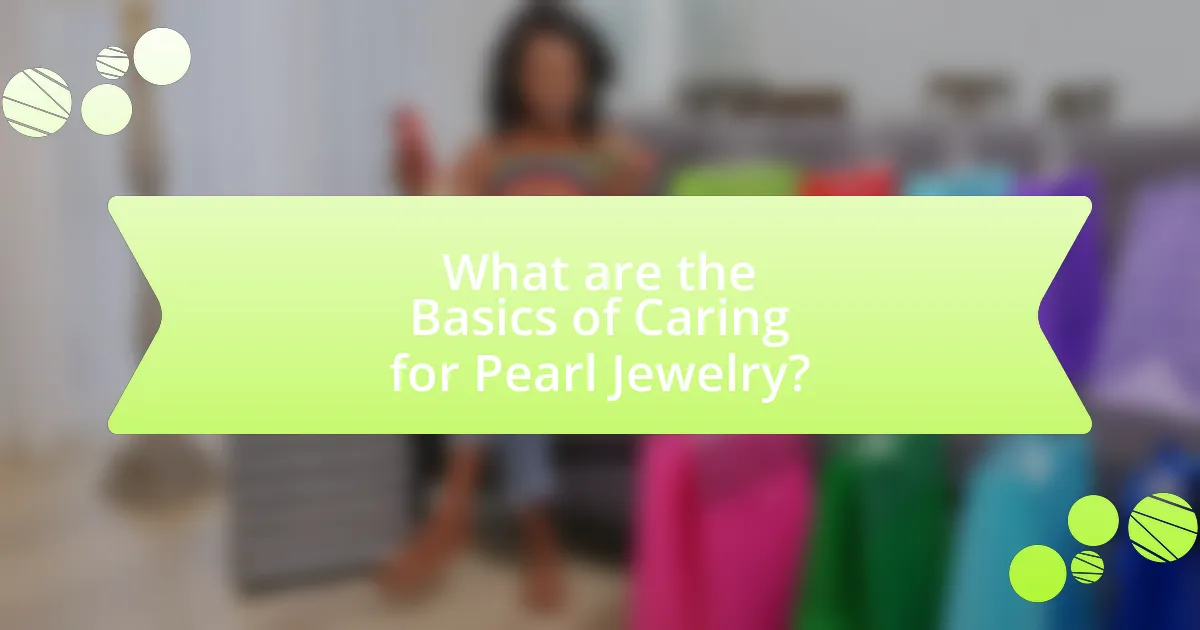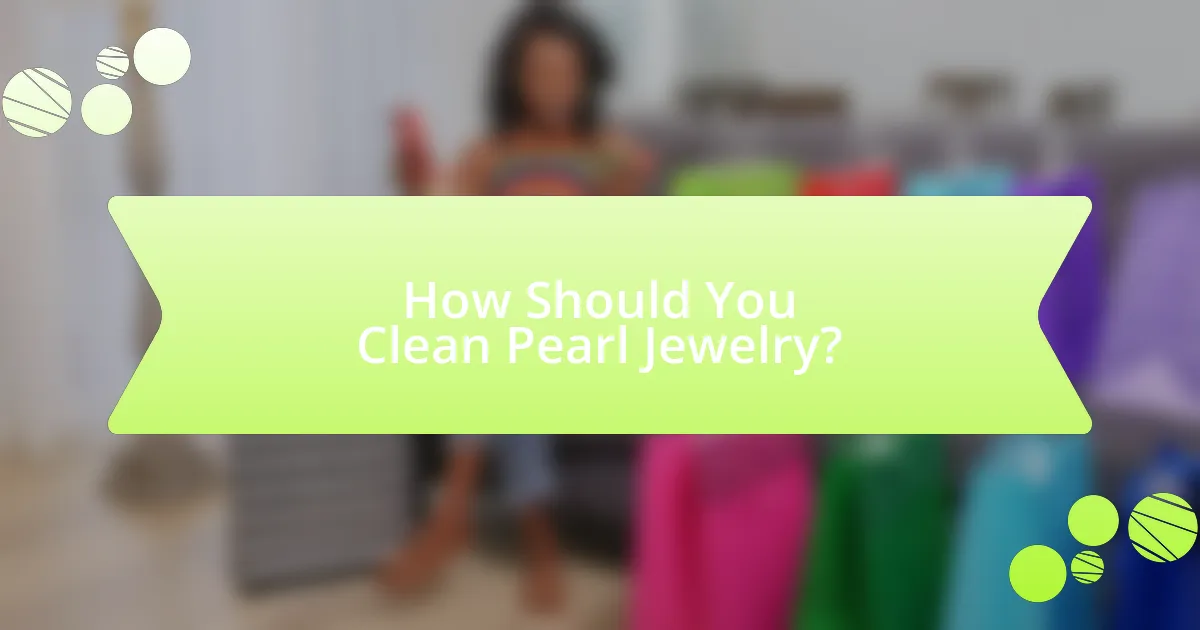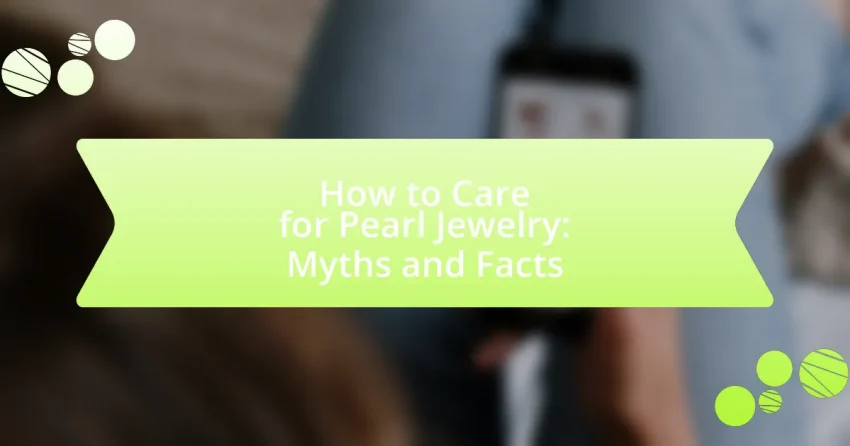The article focuses on the essential practices for caring for pearl jewelry, emphasizing the importance of regular cleaning, proper storage, and avoiding harsh chemicals. It highlights the unique properties of pearls that necessitate special care, such as their organic composition and susceptibility to damage. Common misconceptions about pearl care, including beliefs about their durability and cleaning methods, are addressed to clarify the best practices for maintaining their beauty and longevity. The article also provides practical tips for cleaning and storing pearls, ensuring they remain in optimal condition over time.

What are the Basics of Caring for Pearl Jewelry?
The basics of caring for pearl jewelry include regular cleaning, proper storage, and avoiding exposure to harsh chemicals. To clean pearls, gently wipe them with a soft, damp cloth after each wear to remove oils and dirt. Storing pearls in a soft pouch or a separate compartment in a jewelry box prevents scratches and damage. Additionally, pearls should be kept away from perfumes, hairsprays, and other chemicals that can harm their luster. These practices help maintain the beauty and longevity of pearl jewelry.
Why is proper care essential for pearl jewelry?
Proper care is essential for pearl jewelry because pearls are organic gemstones that can be easily damaged by environmental factors and improper handling. The delicate nature of pearls makes them susceptible to scratches, loss of luster, and deterioration from exposure to chemicals found in cosmetics, perfumes, and even sweat. For instance, a study published in the Journal of Gemmology highlights that pearls can lose their surface quality and shine when exposed to harsh substances, emphasizing the need for careful maintenance. Regular cleaning with a soft cloth and storing pearls separately from other jewelry can significantly prolong their lifespan and preserve their beauty.
What unique properties do pearls have that require special care?
Pearls possess unique properties such as their organic composition, sensitivity to chemicals, and susceptibility to scratching, which necessitate special care. Being composed primarily of calcium carbonate, pearls can be damaged by exposure to harsh chemicals found in perfumes, lotions, and cleaning agents. Additionally, their relatively soft surface, rated 2.5 to 4.5 on the Mohs hardness scale, makes them prone to scratches from harder materials. These characteristics require careful handling, storage away from other jewelry, and cleaning with gentle methods to maintain their luster and integrity.
How does neglecting pearl care affect their appearance and longevity?
Neglecting pearl care significantly diminishes their appearance and longevity. Pearls are organic gemstones that require regular cleaning and proper storage to maintain their luster and structural integrity. Without appropriate care, pearls can become dull, lose their shine, and develop surface damage such as scratches or discoloration. For instance, exposure to harsh chemicals, including perfumes and cleaning agents, can erode the nacre, the iridescent layer that gives pearls their beauty, leading to a shorter lifespan. Studies indicate that pearls can last for generations with proper maintenance, but neglect can reduce their lifespan to just a few years.
What are the common misconceptions about pearl care?
Common misconceptions about pearl care include the belief that pearls are indestructible and can be cleaned with harsh chemicals. In reality, pearls are organic gemstones that can be damaged by exposure to acids, perfumes, and household cleaners. Additionally, many people think that pearls should be stored in a dry environment; however, they actually benefit from humidity, which helps maintain their luster. Another misconception is that pearls do not require regular cleaning; in fact, they should be gently wiped with a soft cloth after each wear to remove oils and dirt. These misconceptions can lead to improper care, ultimately diminishing the beauty and longevity of pearl jewelry.
Why do people believe pearls are indestructible?
People believe pearls are indestructible due to their natural formation process and historical perceptions of durability. Pearls are created by mollusks as a defense mechanism against irritants, leading to the belief that they possess exceptional resilience. Additionally, their lustrous appearance and long-standing association with luxury contribute to the misconception of being unbreakable. However, pearls are organic gems that can be damaged by harsh chemicals, extreme temperatures, and physical impact, contradicting the belief in their indestructibility.
What myths exist about cleaning and storing pearls?
Myths about cleaning and storing pearls include the belief that pearls can be cleaned with harsh chemicals or ultrasonic cleaners, which can damage their surface and luster. Additionally, some people think that storing pearls in airtight containers is ideal; however, this can lead to moisture buildup and potential deterioration. It is also a common misconception that pearls do not require regular cleaning, while in reality, they benefit from gentle cleaning with a soft cloth after each wear to remove oils and dirt. These myths can lead to improper care, ultimately affecting the longevity and appearance of pearl jewelry.

How Should You Clean Pearl Jewelry?
To clean pearl jewelry, gently wipe the pearls with a soft, damp cloth after each wear to remove oils and dirt. This method is effective because pearls are sensitive to harsh chemicals and abrasive materials, which can damage their surface. For deeper cleaning, use lukewarm water mixed with a mild soap, ensuring the cloth is only slightly damp, and avoid soaking the pearls. This approach is validated by experts who recommend avoiding ultrasonic cleaners and steam cleaning, as these can harm the delicate structure of pearls.
What are the recommended cleaning methods for pearls?
The recommended cleaning methods for pearls include using a soft, damp cloth to gently wipe the surface after each wear, and occasionally cleaning them with a mild soap solution. This method ensures that dirt and oils are removed without damaging the delicate surface of the pearls. It is important to avoid harsh chemicals, ultrasonic cleaners, and abrasive materials, as these can harm the luster and integrity of the pearls. Regular maintenance with these gentle methods helps preserve the beauty and longevity of pearl jewelry.
How can you safely clean pearl jewelry at home?
To safely clean pearl jewelry at home, gently wipe the pearls with a soft, damp cloth after each wear to remove oils and dirt. This method is effective because it prevents buildup without damaging the delicate surface of the pearls. Avoid using harsh chemicals or ultrasonic cleaners, as these can harm the nacre of the pearls. Instead, if deeper cleaning is necessary, mix a small amount of mild soap with water, dampen a cloth with the solution, and carefully clean the pearls, followed by rinsing with clean water and drying with a soft cloth. This approach is supported by jewelers who recommend gentle cleaning methods to maintain the luster and integrity of pearl jewelry.
What cleaning products should be avoided for pearls?
Cleaning products that should be avoided for pearls include ammonia-based cleaners, bleach, and any abrasive substances. These products can damage the delicate surface of pearls, leading to discoloration and deterioration. Ammonia and bleach are particularly harmful as they can strip away the natural luster and finish of the pearls, while abrasives can scratch and dull their surface. Therefore, it is essential to use gentle, pH-balanced cleaners specifically designed for pearls to maintain their beauty and integrity.
How often should you clean your pearl jewelry?
You should clean your pearl jewelry after each wear. Pearls are sensitive to dirt, oils, and chemicals, which can damage their luster. Regular cleaning helps maintain their appearance and longevity. Experts recommend using a soft, damp cloth to gently wipe the pearls, ensuring they remain in good condition.
What factors influence the frequency of cleaning pearls?
The frequency of cleaning pearls is influenced by factors such as the frequency of wear, exposure to cosmetics and environmental pollutants, and the type of pearl. Regular wear can lead to the accumulation of oils and dirt, necessitating more frequent cleaning. Pearls exposed to cosmetics, perfumes, or lotions require cleaning after each use to maintain their luster. Additionally, natural pearls may need different care compared to cultured pearls, as their surface characteristics can vary. Regular maintenance is essential to preserve the beauty and integrity of pearl jewelry.
How can you tell when your pearls need cleaning?
You can tell when your pearls need cleaning by observing their luster and surface appearance; if they appear dull, dirty, or have visible smudges, it is time to clean them. Pearls are organic gems that can absorb oils and dirt from skin contact, which diminishes their shine. Regular inspection for these signs is essential, as maintaining their cleanliness helps preserve their beauty and longevity.

What are the Best Practices for Storing Pearl Jewelry?
The best practices for storing pearl jewelry include keeping pearls in a soft cloth pouch or a separate compartment in a jewelry box to prevent scratches. Pearls are sensitive to temperature and humidity, so they should be stored in a cool, dry place away from direct sunlight. Additionally, avoid storing pearls with other jewelry pieces that may cause abrasion, as pearls can be easily damaged. These practices help maintain the luster and integrity of the pearls over time.
How should you store pearl jewelry to prevent damage?
To prevent damage to pearl jewelry, store it in a soft cloth pouch or a dedicated jewelry box lined with fabric. This method protects pearls from scratches and exposure to harsh chemicals. Pearls are sensitive to moisture and temperature changes, so keeping them in a cool, dry place away from direct sunlight is essential. Additionally, avoid storing pearls with other jewelry to prevent abrasion. These practices are supported by the fact that pearls can be easily scratched or damaged due to their organic composition, which is softer than most gemstones.
What types of storage materials are safe for pearls?
Safe storage materials for pearls include soft, breathable fabrics such as silk or cotton. These materials prevent scratches and allow moisture to escape, which is essential for maintaining the luster of pearls. Additionally, using a padded jewelry box or a dedicated pearl pouch can further protect pearls from physical damage and environmental factors. Studies indicate that pearls are sensitive to extreme temperatures and humidity, making breathable storage options crucial for their longevity.
Why is it important to keep pearls away from certain substances?
It is important to keep pearls away from certain substances because they are sensitive to chemicals that can damage their surface and luster. Pearls are composed of calcium carbonate, which can be adversely affected by acids, alkalis, and harsh cleaning agents. For example, exposure to substances like vinegar, bleach, or ammonia can lead to discoloration and deterioration of the pearl’s nacre, ultimately reducing its value and beauty.
What environmental factors affect pearl jewelry storage?
The environmental factors that affect pearl jewelry storage include humidity, temperature, light exposure, and air quality. Pearls are organic gems that can be damaged by extreme conditions; for instance, high humidity can promote mold growth, while low humidity can lead to drying and cracking. Ideal storage conditions for pearls are a cool, dark place with stable temperatures, typically between 65°F to 75°F (18°C to 24°C) and humidity levels around 40-60%. Additionally, exposure to direct sunlight can cause discoloration and deterioration of the pearl’s surface. Proper air quality is also crucial, as pollutants can harm the luster and integrity of pearls.
How does humidity impact the condition of pearls?
Humidity significantly affects the condition of pearls by influencing their luster and structural integrity. High humidity can lead to the pearls absorbing moisture, which may cause them to swell and potentially crack, while low humidity can result in drying out, leading to a dull appearance and increased brittleness. Research indicates that pearls are organic gems composed of calcium carbonate, which is sensitive to environmental changes; thus, maintaining a stable humidity level between 40% and 70% is crucial for preserving their quality.
What temperature conditions are ideal for storing pearls?
The ideal temperature conditions for storing pearls are between 18°C to 24°C (65°F to 75°F). Maintaining this temperature range helps preserve the luster and integrity of the pearls, as extreme temperatures can lead to damage such as drying out or discoloration. Additionally, pearls are organic gemstones that can be sensitive to environmental changes, making consistent temperature control essential for their longevity.
What are some practical tips for maintaining pearl jewelry?
To maintain pearl jewelry, clean it regularly with a soft, damp cloth after each wear to remove oils and dirt. This practice helps preserve the luster and prevents buildup that can damage the surface. Additionally, store pearl jewelry in a soft pouch or lined box to avoid scratches and exposure to harsh chemicals, as pearls are sensitive to substances like perfumes and hairsprays. It is also advisable to wear pearls last when dressing and remove them before engaging in activities that may expose them to sweat or chemicals. These tips are essential because pearls are organic gems that require careful handling to maintain their beauty and longevity.
How can you protect pearls from everyday wear and tear?
To protect pearls from everyday wear and tear, store them separately in a soft cloth or pouch to prevent scratches. Pearls are sensitive to chemicals and moisture, so avoid exposing them to perfumes, lotions, and sweat. Regularly clean pearls with a soft, damp cloth to remove dirt and oils, ensuring they maintain their luster. Additionally, wear pearls after applying makeup and remove them before engaging in activities that may cause impact or exposure to harsh conditions. These practices help preserve the integrity and appearance of pearls, which are composed of aragonite and conchiolin, making them delicate and susceptible to damage.
What should you do before and after wearing pearl jewelry?
Before wearing pearl jewelry, clean it gently with a soft, lint-free cloth to remove any dirt or oils that may have accumulated. This step is crucial because pearls are porous and can absorb substances that may damage their surface. After wearing pearl jewelry, wipe it again with a soft cloth to remove any makeup, perfume, or skin oils, which can lead to deterioration over time. Regular maintenance, including these cleaning practices, helps preserve the luster and integrity of pearls, ensuring their longevity.
